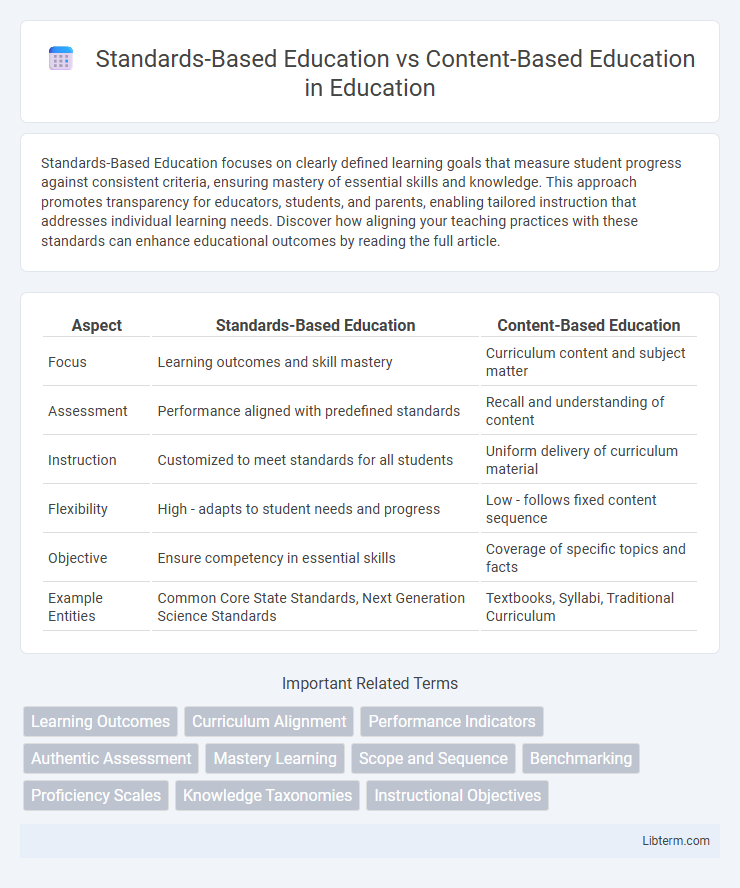Standards-Based Education focuses on clearly defined learning goals that measure student progress against consistent criteria, ensuring mastery of essential skills and knowledge. This approach promotes transparency for educators, students, and parents, enabling tailored instruction that addresses individual learning needs. Discover how aligning your teaching practices with these standards can enhance educational outcomes by reading the full article.
Table of Comparison
| Aspect | Standards-Based Education | Content-Based Education |
|---|---|---|
| Focus | Learning outcomes and skill mastery | Curriculum content and subject matter |
| Assessment | Performance aligned with predefined standards | Recall and understanding of content |
| Instruction | Customized to meet standards for all students | Uniform delivery of curriculum material |
| Flexibility | High - adapts to student needs and progress | Low - follows fixed content sequence |
| Objective | Ensure competency in essential skills | Coverage of specific topics and facts |
| Example Entities | Common Core State Standards, Next Generation Science Standards | Textbooks, Syllabi, Traditional Curriculum |
Introduction to Education Models
Standards-Based Education emphasizes measurable learning outcomes aligned with specific academic standards, ensuring consistency and accountability across educational systems. Content-Based Education prioritizes the delivery of subject matter knowledge without necessarily linking it to defined competency benchmarks or skill mastery. Understanding these education models highlights the shift from traditional content delivery toward outcome-driven approaches that enhance student achievement and instructional clarity.
Defining Standards-Based Education
Standards-Based Education focuses on clearly defined learning goals aligned with specific academic standards, ensuring students achieve measurable competencies. This approach emphasizes mastery of skills and knowledge through consistent assessment and feedback, promoting accountability and targeted instruction. Unlike Content-Based Education, which prioritizes curriculum topics, Standards-Based Education directs teaching and learning toward demonstrable outcomes tied to standardized benchmarks.
Understanding Content-Based Education
Content-Based Education centers on delivering subject matter knowledge through structured curricula designed to cover comprehensive topics within a discipline. It emphasizes mastery of specific content areas, often prioritizing memorization and recall of factual information over skill application. This approach can limit the development of critical thinking and real-world problem-solving skills by focusing predominantly on standardized content delivery.
Key Differences Between the Approaches
Standards-Based Education emphasizes mastery of specific learning outcomes aligned with predefined academic standards, promoting consistency and measurable progress across diverse classrooms. Content-Based Education centers on the delivery of subject matter without necessarily linking to uniform benchmarks, often focusing on breadth rather than depth of knowledge. Key differences include assessment methods, where Standards-Based Education uses criterion-referenced evaluations to track student proficiency, while Content-Based relies on traditional grading tied to content coverage.
Curriculum Design and Implementation
Standards-Based Education emphasizes curriculum design that aligns learning objectives with clearly defined standards, ensuring consistent assessment and measurable outcomes across diverse classrooms. Content-Based Education focuses on covering specific subject matter in depth, prioritizing comprehensive knowledge acquisition over uniform learning benchmarks. Effective implementation of Standards-Based Education requires ongoing alignment of instructional materials and assessments with standards, while Content-Based Education centers on expert-driven content sequencing and mastery of predefined topics.
Assessment Methods and Outcomes
Standards-Based Education emphasizes assessments aligned with specific learning standards, measuring student proficiency through clear, measurable objectives to ensure consistent achievement across diverse learners. Content-Based Education relies on assessments that evaluate the mastery of curricular material, often focusing on recall and comprehension of information rather than the demonstration of applied skills. Outcomes in Standards-Based Education are typically more transparent and comparable, facilitating targeted interventions, while Content-Based outcomes may vary in rigor and relevance, impacting the ability to gauge true student understanding effectively.
Impact on Student Learning and Achievement
Standards-Based Education emphasizes clear, measurable learning goals that align with proficiency levels, resulting in improved student learning outcomes and higher achievement by targeting specific competencies. Content-Based Education focuses on delivering subject matter knowledge without explicit performance benchmarks, often leading to varied student mastery and inconsistent achievement gains. Research indicates that Standards-Based Education fosters greater accountability and tailored instruction, enhancing overall academic performance.
Teacher Roles and Responsibilities
In standards-based education, teachers focus on facilitating student mastery of clearly defined learning objectives aligned with state or national standards, emphasizing personalized assessment and data-driven instruction. Content-based education assigns teachers the responsibility to deliver subject matter comprehensively, prioritizing content coverage over individual student performance metrics. Educators in standards-based systems often act as facilitators of learning progress and skill development, while in content-based frameworks, they primarily serve as knowledge transmitters responsible for thorough curriculum delivery.
Challenges and Criticisms
Standards-Based Education faces challenges such as rigid curriculum frameworks that limit teacher creativity and often ignore individual student needs, resulting in teaching to the test rather than fostering critical thinking. Content-Based Education is criticized for its emphasis on memorization and coverage of vast information, which may overwhelm students and hinder deep understanding or skill development. Both approaches struggle with balancing standardized assessments and personalized learning, making it difficult to address diverse learner capabilities effectively.
Future Trends in Educational Frameworks
Future trends in educational frameworks emphasize a shift from Content-Based Education towards Standards-Based Education, prioritizing mastery of skills and competencies aligned with clear, measurable standards. This transition supports personalized learning pathways and integrates technology to track student progress, fostering adaptability in diverse learning environments. Emerging frameworks increasingly incorporate interdisciplinary standards and real-world applications to prepare students for dynamic workforce demands.
Standards-Based Education Infographic

 libterm.com
libterm.com